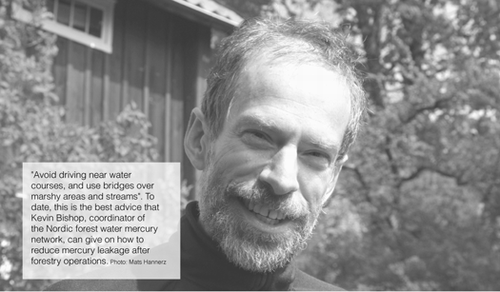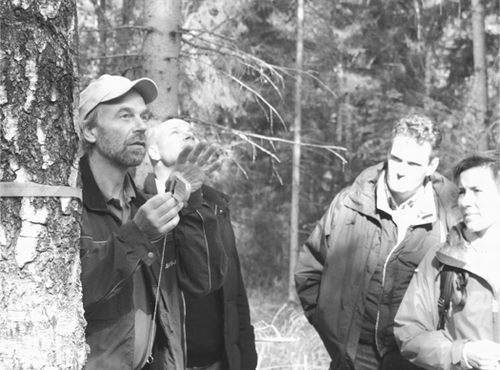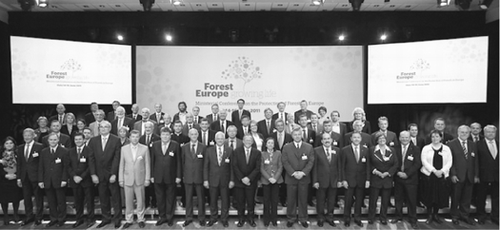SNS grips mercury and forestry
 Mercury leakage as a result of forestry operations is a much debated topic, but it remains a scientific puzzle. In 2005, Kevin Bishop could count the relevant scientific studies on one hand, but the message was clear – forest harvest always led to greatly increased mercury in aquatic foodwebs. Today, it takes both hands and a few toes to count the published studies, but the picture is more complex, with some harvests having been found to lead to minimal increases in mercury loading.
Mercury leakage as a result of forestry operations is a much debated topic, but it remains a scientific puzzle. In 2005, Kevin Bishop could count the relevant scientific studies on one hand, but the message was clear – forest harvest always led to greatly increased mercury in aquatic foodwebs. Today, it takes both hands and a few toes to count the published studies, but the picture is more complex, with some harvests having been found to lead to minimal increases in mercury loading.
Professor Kevin Bishop is co-ordinating the SNS-supported network Nor-ForM (the Nordic forest water mercury network), which brings together Nordic expertise relating to the environmental effects of mercury in forests.
The negative effects on health from mercury have long been known. When mercury was used in making hats, those who breathed the mercurious vapours had a tendency to tremble and act as if they were insane. Thus, the expression “mad as a hatter” was coined in the early 19th century.
– Today, it is well-known that mercury, primarily methylmercury, can seriously damage human health, mainly through effects on the nervous system of foetuses and children, says Kevin Bishop.
Mercury in fish – a big problem
Consumption of fish is the primary means of human exposure to mercury in most of the developed world. Because fish has many benefits for humans, such as providing omega-3 fatty acids, it is important to understand what can be done to reduce mercury levels in fish.
Mercury in fish remains both a major environmental problem and a scientific puzzle. In many Fennoscandian lakes, fish have levels of mercury exceeding the recommended limit for regular human consumption. Due to international emission control efforts, the deposition of mercury has decreased. But the concentrations in freshwater fish, such as pike and perch, are still high, and even increasing according to some studies.
– Although much of the mercury found in soils arrived as airborne pollutants emitted elsewhere in the world, research from the Nordic countries and Canada has shown that forestry operations mobilise mercury from soils to surface waters. This starts mercury on its way up the food chain to fish and those who eat fish, says Kevin Bishop.
A mercury network
The Nor-ForM network was formed in 2010. Its main aim is to provide opportunities for the Nordic mercury research community to meet in order to compare the results of their studies. This supports efforts to improve management strategies for mitigating the bioaccumulation of mercury in forested landscapes contaminated by decades of mercury deposition resulting from anthropogenic emissions.
One of the network's activities was a gathering of 20 Nordic researchers, along with guests from the US and Canada, at the Royal Swedish Academy of Agriculture and Forestry (KSLA) in November 2010. The aim was to discuss the latest research findings relating to these issues. The presentations revealed large differences in the magnitude of the aquatic mercury response to forest operations.
– This variation in the sensitivity of different sites to forest operations with respect to mercury is currently a conundrum, says Kevin Bishop. But if the causes for this variation can be identified, they might hold the key to more effective management measures.
There was a lively discussion about hypotheses to explain these differences; this went on for two days as the meeting continued at another venue.
The participants at the KSLA meeting were subsequently successful in being awarded one of a limited number of special sessions at the International Conference on Mercury as Global Pollutant, held in Canada during the summer of 2011. That special session focussed on the connection between forestry and mercury problems, and can be seen as a direct follow up to the 2010 meeting at KSLA.
Find the “hot spots”
Research cooperation to synthesise many of the results presented at the KSLA conference is ongoing, continues Kevin Bishop. One of the hopes is to identify “hotspots” of methylmercury formation in the landscape, and examine how forestry affects these hotspots.
During autumn 2011, the network is visiting field sites where major mercury studies have been conducted in Sweden, Finland and Norway, in order to build a better basis for synthesising the results.
Don't drive close to water
The best advice that the group can offer forestry for now about how to reduce leakage of mercury is to avoid driving near water courses, and to make use of bridges over marshy areas and streams.
Read more: “Hg – a serious enviromental problem that tends to be overlooked”, Future Forests, Reportage 2
www.futureforest.se , search for the title
Bishop, K. et al. 2009. Bioaccumulation of Hg in boreal freshwaters–- an assessment of contribution by forestry based on available data and current recommendations for good silvicultural practice. Ambio 38 (7), 373–380.
Contact: [email protected]
Distance learning course in forestry celebrates ten-year anniversary
Since their initiation in 2001, appr. 2,000 forest owners and others with an interest in forests have taken academic courses in sustainable small-scale forestry at the Linnaeus University in southern Sweden. The distance learning courses attract forest owners from all over Sweden, who want to deepen their knowledge and understanding of how to manage their forest holdings. In Sweden, more than half of the forest land is owned by non-industrial forest owners.
The 10-year anniversary will be celebrated with a seminar in Växjö in November 2011.

Read more: www.lnu.se
Forest owners meet a few times during the distance course to practice management and mensuration. Photo: Mats Hannerz
First year as IUFRO president
The worldwide organisation IUFRO has been led from Denmark since the world congress in Seoul in 2010, and this will continue until the next such event in Salt Lake City in 2014. News & Views asked Professor Niels Elers Koch to share his experiences from his first year as IUFRO President.
Do you want to highlight a particular event during this year?
– The most exciting event in 2011 was the scientific seminar we had 24-25 February in Helenental, Austria. It was the first event of this kind in the history of IUFRO. The Enlarged Board of IUFRO, with approximately 50 members, spent two full days discussing the six thematic areas of the IUFRO Strategy 2010–2014 with the world's leading experts.
Have any significant changes been launched within the organisation?
– Yes, based on the discussions I mentioned, the Board of IUFRO approved six new Task Forces for the six thematic areas. These are:
| • | Forests for people | ||||
| • | Forests and climate change | ||||
| • | Forest bioenergy | ||||
| • | BIODIVERSITY and ecosystem services | ||||
| • | Forest and water interactions, and | ||||
| • | Resources for the future. | ||||
These Task Forces will work closely with IUFRO's nine permanent divisions on an interdisciplinary basis. They will add value to the scientific discourse, assess and synthesise existing knowledge and identify gaps. Their results will be presented at the next IUFRO World Congress, 5–10 October 2014 in Salt Lake City, USA.

I assume that the position involves a lot of travelling
– Yes, I travel nearly once a month to attend IUFRO meetings all over the world, and I am very grateful to the Heilmann Foundation, which finances my travels. All places are exciting for me to visit, but unfortunately I do not have the time to participate in excursions or do much sight-seeing.
Professor Niels Elers Koch is President of the International Union of Forest Research Organizations (IUFRO) for the period 2010– 2014. Professor Koch is also Director General of the Danish Centre for Forest, Landscape and Planning, and a long-term and active board member in SNS. Photo: Christoffer Regild.
What does IUFRO mean to the Nordic forest academics?
Especially Finland, where both Metla and the Finnish Ministry for Foreign Affairs have been valuable partners in the work of IUFRO, and also Sweden, which has two members on the IUFRO Board this term. However, the great value of IUFRO is that it is the global network for forest-related research and serves the needs of all forest researchers and decision-makers worldwide.
Can you estimate how much time you spend on your duties as President?
I dedicate on average about 20 hours each week to IUFRO work. These are on top of my daily work for the Danish Centre for Forest, Landscape and Planning. I do this voluntarily in my free time and without any payment because IUFRO has been of great benefit to me and the forest researchers in the institution I head. Of course, I – and all the other 600 or so officeholders of IUFRO – could not do our work without the great support we get from IUFRO Headquarters in Vienna. Most of the twelve or so staff members there are paid by the Austrian Ministry for Agriculture, Forestry, Environment and Water Management.
ABOUT IUFRO

IUFRO (International Union of Forest Research Organizations) is “the” global network for forest science cooperation. It unites more than 15,000 scientists in almost 700 member organisations in over 110 countries, who cooperate in IUFRO on a voluntary basis.
The mission of IUFRO is to promote the coordination of, and the international cooperation in, scientific studies embracing the whole field of research related to forests and trees for the well-being of forests and the people who depend on them.
New research directors at Metla
Dr. Taneli Kolström and Dr Leena Paavilainen have been appointed Directors of research at the Finnish Forest Research Institute (Metla). The research directors are responsible for coordinating, developing and steering Metla's research activities.
Source: www.metla.fi

…towards a forest agreement in Europe
In June, 2011, a decision was made to launch negotiations aimed at drawing up a legally binding agreement on forests in Europe. The FOREST EUROPE Ministerial Conference Oslo 2011 gathered ministers and high-level representatives from 42 FOREST EUROPE countries, along with observers from countries outside Europe and from international organisations.
An intergovernmental negotiating committee will be established with mr Jan Heino, Finland, as chairman. The committee will accomplish its work no later than 30 June 2013. The legally binding framework agreement will address subjects such as:
| • | ensuring sustainable forest management in Europe and the long-term provision of a broad range of goods and forest ecosystem services | ||||
| • | maintaining and enhancing forest resources in Europe: their health, vitality and resilience, and their adaptation to climate change | ||||
| • | increasing the resilience of forests to natural hazards and protecting forests from human-induced threats | ||||
| • | halting the loss of forest biodiversity in Europe and combating desertification | ||||
| • | reducing illegal logging and the associated trade in timber and timber products. | ||||
Many more details can be found on Forest Europe's webpage
Forestry students met in Finland
The International Forestry Student's Association (IFSA) visited Finland for its 39th annual symposium. About 120 forestry students from some 30 nations all over the world travelled around Finland to learn more about the Finnish forestry sector and the country's culture, and also to establish new networks. This was the second time the symposium was held in Finland. The previous visit was 20 years ago.
IFSA is a global network for students studying forest sciences, uniting 3000 students in 54 countries. IFSA is a non-governmental, not for profit and non religious organisation run entirely by students for students.
Sources: www.uef.fi; www.ifsa.net
More to cut in Norway
The Nord-Trøndelag fylke in central Norway has a tree growth that exceeds the harvest by a factor of three. There is huge potential to increase the amount of cutting, according to the Norwegian politician Inge Ryan, who opened the conference Forest Management and Silviculture in the North.
The conference was held in September 2011 in Stjørdal in Norway, and attracted about 50 forest scientists from Europe and Canada. The programme included topics such as silviculture in times of climate change, and multifunctional forestry and environmental services.
The conference was arranged by IUFRO together with SNS and the Norwegian Forest and Landscape Institute.
Source: www.skogoglandskap.no